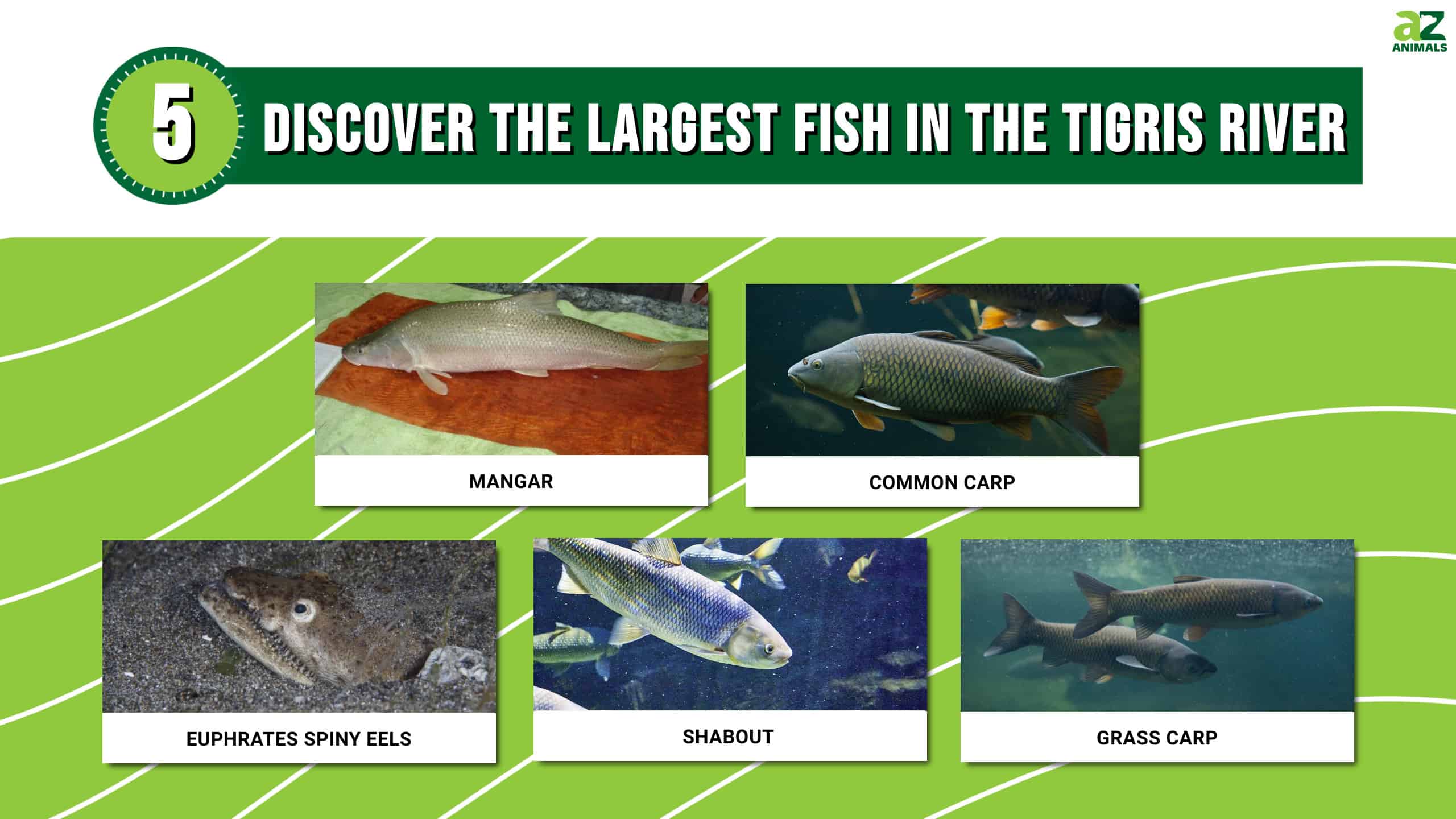
As an important waterway in West Asia, also known as the Middle East, the Tigris River is home to an array of remarkable fish species, each contributing to the richness of its aquatic life. The river is home to a diverse collection of native and introduced species, with some growing considerably.
Let’s explore six of the largest fish in the Tigris River, including their size, appearance, habitat, diet, conservation status, and where to spot them.

Multiple carp species reside in the Tigris River.
©Jane Rix/Shutterstock.com
Where is the Tigris River Located?
As we explore some of the largest fish in the Tigris River, let’s quickly go over where the Tigris River is located to understand the geographical location of these fish.
The Tigris River is a significant waterway that flows through the Middle East. It is a beautiful and historic river known for its crucial role in shaping the ancient civilizations of Mesopotamia, including the Sumer, Akkad, Babylonia, Assyria, and the Abbasid Caliphate.
The river begins from Lake Hazar, located in the Taurus Mountains in southeastern Turkey. That is also referred to as the Armenian Highlands. Its length runs for approximately 1,090 miles (1,750 kilometers) through Turkey, Syria, and Iraq before joining the Euphrates River to form the Shatt al-Arab, which eventually empties into the Persian Gulf.
Additionally, the Tigris River and its sister river, the Euphrates, cradles the region historically known as Mesopotamia, which is aptly named “between rivers.” Both river run parallel to one another and are home to many of the same fish species.
The Tigris River’s waters are sourced primarily from snowmelt and rainfall in the Taurus Mountains of Turkey. The journey of the Tigris is not just about geographical progression. The river transforms when comparing its start point to its endpoint. At its starting point as a fresh, fast-moving body in the rugged mountains of Turkey, it gradually morphs into a broader, more relaxed flow of water as it moves through the plains of Iraq.
Along its course, the Tigris feeds marshes, aids agriculture, and supports an array of aquatic life, such as the largest fish in the Tigris River. It also serves as an essential transportation route through a significant length of desert within Iraq and Syria.
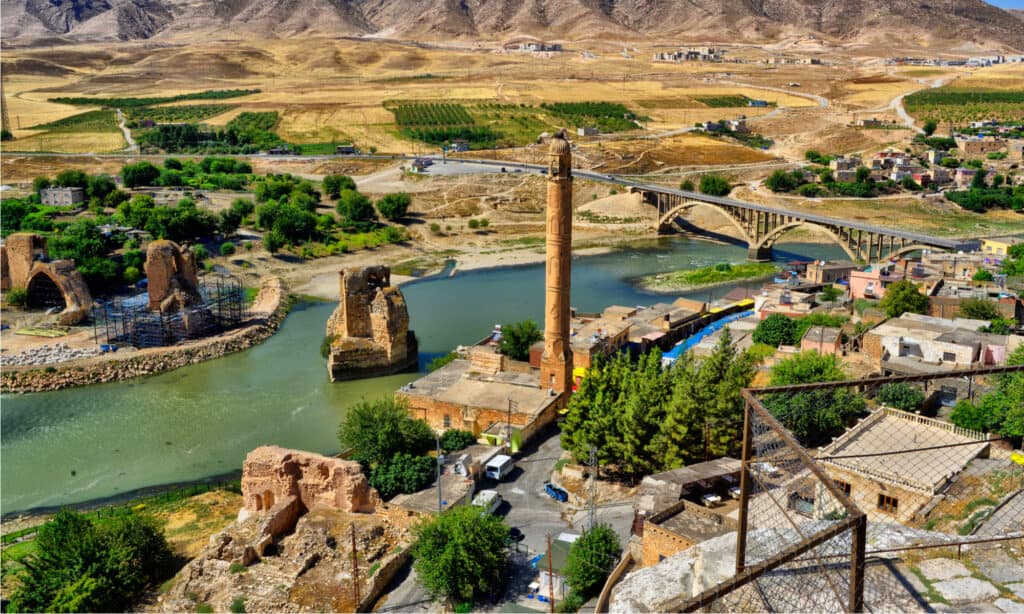
The Tigris River is home to some of the largest fish species in the world.
©Sanatkar/Shutterstock.com
1. Mangar
Within the Tigris River lives a mighty and impressively large fish known as the Mangar (Luciobarbus esocinus). Many people consider it the largest fish in the Tigris River.
Size is a defining characteristic of the Mangar. This fish often measures an impressive 3 to 5 feet on average. Some individuals, however, have been known to outgrow this average size and reach a striking 7.5 feet in length. In terms of weight, this aquatic titan can tip the scales at an extraordinary 100 to 300 pounds or more.
The Mangar’s appearance is as striking as its size. These fish are toothless, and four barbels surround their mouths. Their heads are large, with sleek small scales covering their long bodies. Across their bodies, they are predominately silver with lighter underbellies. In contrast, their single dorsal fin, pectoral fins, ventral fins, anal fins, and tail are a palette of fair olive-green or pale yellow.
In the sprawling expanses of the Tigris River, Mangar is found from the upper reaches of Turkey to the lower stretches of Iraq. They most commonly reside in the drainage basins of the Tigris rivers in Iraq, Syria, and Turkey. Furthermore, mature Mangar migrates to smaller inflows to spawn.
With a diet that includes a variety of invertebrates, fish, amphibians, zooplankton, phytoplankton, and even birds, Mangar are opportunistic predators. Their dietary preferences shift as they mature, with smaller, young Mangar feeding on invertebrates, while their larger, adult counterparts opt for fish and amphibians. Overall, fish make up about half of their diet.
Fishing for Mangar is a popular activity that can require patience. Their large size and tenacious fight offer a thrilling challenge. However, their popularity among anglers and declining numbers underscore the importance of responsible fishing practices.
Conservation Status of Mangar
Despite their dominance in the Tigris, Mangar face threats that have landed them a vulnerable status by the International Union for Conservation of Nature (IUCN) list. Despite insufficient population data, overfishing, pollution, drought, and habitat degradation are key factors. These contribute to their declining population, underlining the need for robust conservation strategies.

Mangars have long, streamlined bodies.
©maleek silawi / CC BY 3.0 – License
2. Common Carp
Many carp species call the Tigris River home. The Common Carp (Cyprinus carpio), so conveniently named, is one of the common species residing here.
They are usually measured in length between 16 to 31 inches and weigh 5 to 30 pounds. The Common Carp doesn’t shy away from reaching grander sizes. However, it does not grow as large as the domesticated Common Carp, which can grow to sizes of roughly 40 to 50 inches in length and 75 to 90 pounds.
The Common Carp’s appearance is distinguished by a robust, elongated body that gradually narrows towards the tail. Their bodies can be varying shades of golden bronze. They are covered in large, shiny scales, with a pair of barbels adorning each side of their wide, downward-pointing mouth, giving them a distinct, almost mythical appearance. Their large pectoral fins, tapering dorsal fins, tail, and anal fins can be a dark bronze or an orange hue.
The habitat of the Common Carp within the Tigris River is a reflection of their adaptability. These schooling fish are not native to the Tigris River. Due to their adaptability, they tolerate many conditions and are often spotted in groups of five or more. However, within the Tigris River, they have a preference for slow-moving water or standing water, in addition to vegetative sediments.
The diet of the Common Carp is as versatile as their habitat. They are omnivorous. Their diet consists of aquatic plants, plant tubers, seeds, insects, crustaceans such as zooplankton and crawfish, mollusks, benthic worms, fish eggs, and fish remains. Their varied diet contributes significantly to their survival and spread across the Tigris.
As for this non-native species, there are no fishing regulations within the Tigris River. Of the many varieties, they are a common catch. If you’re keen on spotting Common Carp in the Tigris River, focus on searching in calmer areas with plenty of aquatic vegetation, as these environments offer food and protection for the carp.
Conservation Status of Common Carp
In terms of conservation, native Common Carp are listed as vulnerable by the IUCN. However, regarding the Tigris River, the Common Carp are not native but an invasive species. Local overfishing or habitat alterations put this species at risk, regardless.

Wild Common Carp do not grow as large as domesticated Common Carp.
©Vladimir Wrangel/Shutterstock.com
3. Euphrates Spiny Eels
The Euphrates Spiny Eel or Mesopotamian Spiny Eel (Mastacembelus mastacembelus) is a cryptic resident of the Tigris River. With their serpentine form and secretive habits, these eels provide an element of mystery and intrigue.
Euphrates Spiny Eels can grow to notable lengths. This eel typically reaches an average length of about 1.5 feet and a weight of half a pound.
Their appearance is long, slender, and tubular. Their dorsal fin, tail, and anal fin blend seamlessly together, stretching over half the length of their bodies. They are usually brown or grayish, often with lighter spotted, speckled, or mottled vertical-like patterns.
The habitat of the Euphrates Spiny Eel within the Tigris River generally consists of areas with soft bottoms where they can easily hide or burrow, such as the riverbed substrates. Like many eels, these eels are born in the ocean and then migrate up rivers and streams until returning to reproduce.
Regarding diet, Euphrates Spiny Eels are predominantly carnivorous, preying on various aquatic invertebrates, insects, small fish, and crustaceans. Their long, slender bodies and nocturnal habits equip them perfectly for a predatory lifestyle.
To spot a Euphrates Spiny Eel, one would need a keen eye and a bit of luck. These elusive creatures are most active during the night and often hide in the riverbed during the day. The best places to look for them in the Tigris River would be areas with soft, muddy bottoms and plenty of cover.
Conservation Status of the Euphrates Spiny Eel
The Euphrates Spiny Eel is listed as least concern by the IUCN. However, localized threats such as pollution or habitat destruction could impact their populations.
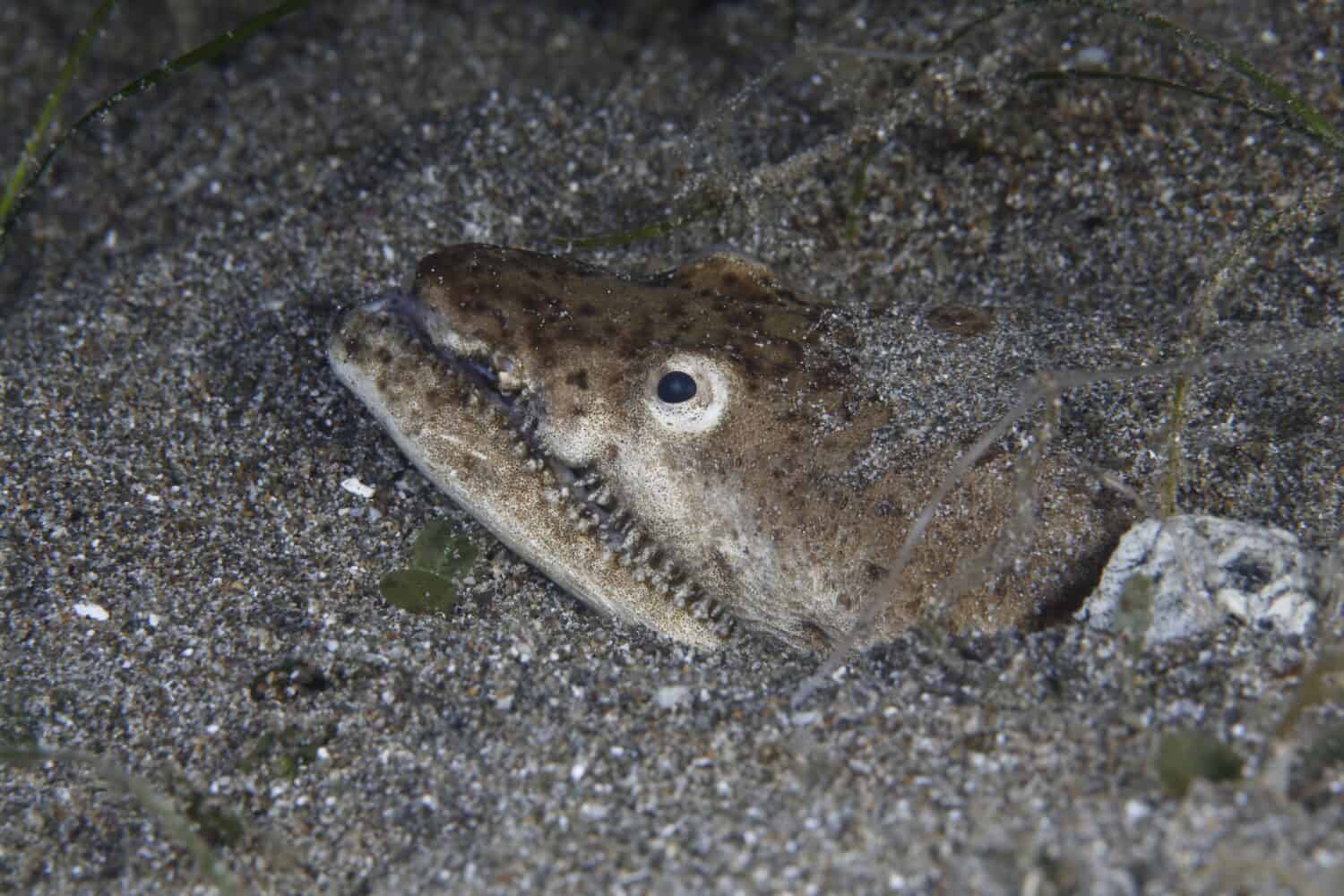
The Euphrates Spiny Eel is classified as a species of least concern on the IUCN list.
©Thierry Eidenweil/Shutterstock.com
4. Shabout
The Shabout (Arabibarbus grypus) is another one of the largest fish in the Tigris River. It is also a native fish to this river.
Size-wise, the Shabout is a reasonably large species of carp. The average individual measures between 3 to 5 feet in length and weighs upwards of 65 pounds. However, there have been unconfirmed reports of this fish measuring up to 6.5 feet long and over 220 pounds. However, these reports could have misidentified Mangar.
The Shabout sports a streamlined, elongated body ideal for navigating the river’s flowing waters. Shiney scales blanket its slender body. Its coloration ranges from silver-white to dark gray, with the underbelly typically lighter and a darker short dorsal fin, short ventral fins, pectoral fins, anal fin, and tail.
The habitat of the Shabout within the Tigris River is relatively wide-ranging. They are widely adaptable, but they have high oxygen requirements. Shabout prefers slow to moderately flowing water within the Tigris River. Adults prefer cooler waters during the heat of the summer and can migrate closer to the upper half of the river. Meanwhile, the smaller and younger individuals stay in the lower areas of the river.
The Shabout is omniverous. Their diet consists of a wide range of plants, such as algae and macrophytes, as well as invertebrates and small fish. This broad diet reflects its adaptability to a range of environmental conditions.
Shabout, like many carp, is a popular catch among anglers, both for its size and role in local cuisine. And like many fish, patience is key, as carp tend to be wary and can put up a good fight. Spotting a Shabout in the Tigris River involves seeking out areas with a slow to moderate current. Look out for deeper pools and undercut banks where they may take shelter during the daytime.
Conservation Status of Shabout
The IUCN currently lists Shabout as vulnerable due to threats from overfishing, habitat destruction, pollution, and drought. Its status emphasizes the need for effective management and conservation strategies.
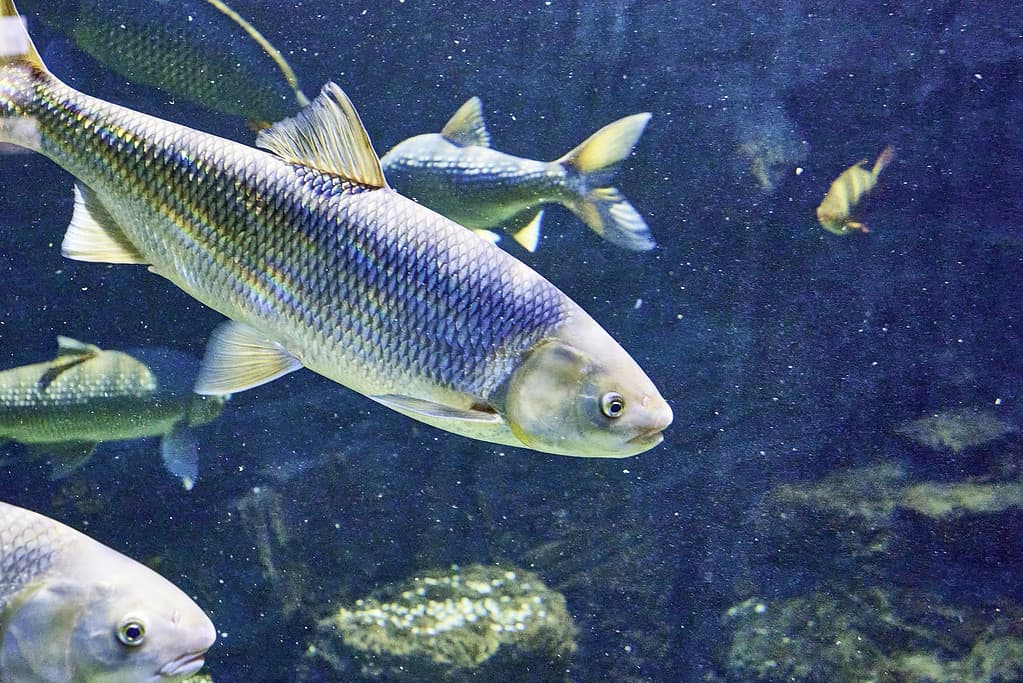
The Shabout is a part of the Cyprinid family.
©Taranukha Sergey/iStock via Getty Images
5. Grass Carp
Grass Carp (Ctenopharyngodon idella) is a fascinating freshwater fish native to Eastern Asia that has found its way to various parts of the globe, including the Tigris River as a non-native resident.
The Grass Carp is an impressively large fish. On average, they grow to around 2 to 6 feet in length. As for weight, they typically tip the scales at about 20 to 100 pounds, making them one of the largest fish in the Tigris River.
Visually, the Grass Carp boasts an elongated, moderately compressed body. Its body has a silver to olive-green to brownish-yellow color. It has dark hues towards its back, pectoral fins, dorsal fins, tail, and anal fins. Meanwhile, it has light whitish hues towards its belly. Its eyes are set low on its head.
Grass Carp generally prefer slow-moving to stagnant water bodies with lush vegetation. They can be found in the main river channel, where water flow is slow and currents are less rough. However, they do spawn in fast-moving sections of the river to help the survival rate of the eggs that must not settle on the riverbed.
The Grass Carp’s diet primarily consists of aquatic plants, detritus, insects, and other invertebrates. This has made them a popular species for intentional aquatic weed control in various water bodies worldwide.
Within the Tigris River, spotting a Grass Carp is a matter of knowing where to look. Focus on areas with a high density of aquatic vegetation where they are likely to feed. They are common to fish for fishing, like many carp, but they must be released if caught in some locations where they are used for aquatic weed control.
Conservation Status of Grass Carp
Grass Carp are listed as a species of least concern on the IUCN list. This is primarily due to their widespread distribution and introduction to vegetation management. However, it’s important to note that their introduction has also raised concerns about potential ecological impacts.

Grass Carp grow up to 2 to 6 feet in length.
©Vladimir Wrangel/Shutterstock.com
Bull Shark
This species often makes unexpected appearances in rivers worldwide. The bull shark, scientifically known as Carcharhinus leucas, can be spotted in the waters of the Tigris River. This resilient shark species is one of the few that can dwell in both freshwater and saltwater, demonstrating impressive adaptability and being one of the largest fish in the Tigris River.
Bull sharks can reach an impressive size, with females being larger than males. On average, these sharks grow to about 7 to 11 feet in length and can weigh up to 200 to 350 pounds. There are reports of rare individuals measuring up to 11 feet in length and weighing upwards of 850 pounds.
At first glance, bull sharks appear robust and stocky with a broad, flat snout and small eyes. Their coloration typically varies from gray to brown on top, gradually fading to a lighter hue on their underbelly, providing natural camouflage. Interestingly, Bull Sharks share some resemblance to the Ganges Shark, which has often led to misidentification between the two species.
Being a top-level predator, bull sharks have a diverse diet. They primarily feed on bony fish, other sharks, rays, dolphins, turtles, birds, mollusks, crustaceans, terrestrial mammals, and carrion. Their wide range of prey indicates their adaptability and predatory nature.
Bull sharks have been sighted along different sections of the Tigris River, reflecting their ability to penetrate deep inland via freshwater systems. However, the exact locations are not well-known. They likely mainly inhabit the second half of the river, with reports of sighting as far north as Baghdad.
Conservation Status of the Bull Shark
The conservation status of Bull Sharks is categorized as vulnerable by the IUCN. While they have a broad global distribution, their populations are declining largely due to overfishing for their meat, fins, liver oil, and as bycatch.

The Bull shark can thrive in both saltwater and freshwater environments.
©Harry Collins Photography/Shutterstock.com
An Ideal Environment for Some of the Largest Fish in the Tigris River
The Tigris River is an ecological powerhouse teeming with life. It creates an exceptional environment for various aquatic species, including some of the largest fish in the Tigris River, such as the Mangar, Common Carp, Grass Carp, Euphrates Spiny Eels, Shabout, and Bull Shark.
The Tigris River courses through diverse landscapes and provides various habitats for many fish species. From rapid stretches to slower flowing parts, from rocky areas to muddy bottoms, and from the main river channel to side lakes and floodplains, the Tigris offers a range of ecological niches for different species.
Temperature, water quality, and oxygen content are other important ecological features of the Tigris River. A relatively warm climate and a temperature that supports high biological productivity provide an ideal environment for the growth and survival of a range of fish species.
One key characteristic of the Tigris River is its lush vegetation, making it a paradise for herbivorous fish like the Grass Carp. The copious amounts of aquatic plants offer a bountiful buffet for these species.
The river’s diverse range of habitats also supports a wealth of prey species, creating a fertile hunting ground for larger predatory fish like the Mangar and the Bull Shark. The Bull Shark, for instance, is known for its incredible adaptability to freshwater environments, making the Tigris an ideal home for this species.
Meanwhile, the Shabout and Euphrates Spiny Eels thrive in the river’s deeper, slower-moving stretches, where they find shelter and abundant food resources.
The Common Carp, an incredibly adaptable species, can be found throughout the river. It thrives in various conditions, whether slow or fast-moving waters, and can tolerate a range of temperatures.
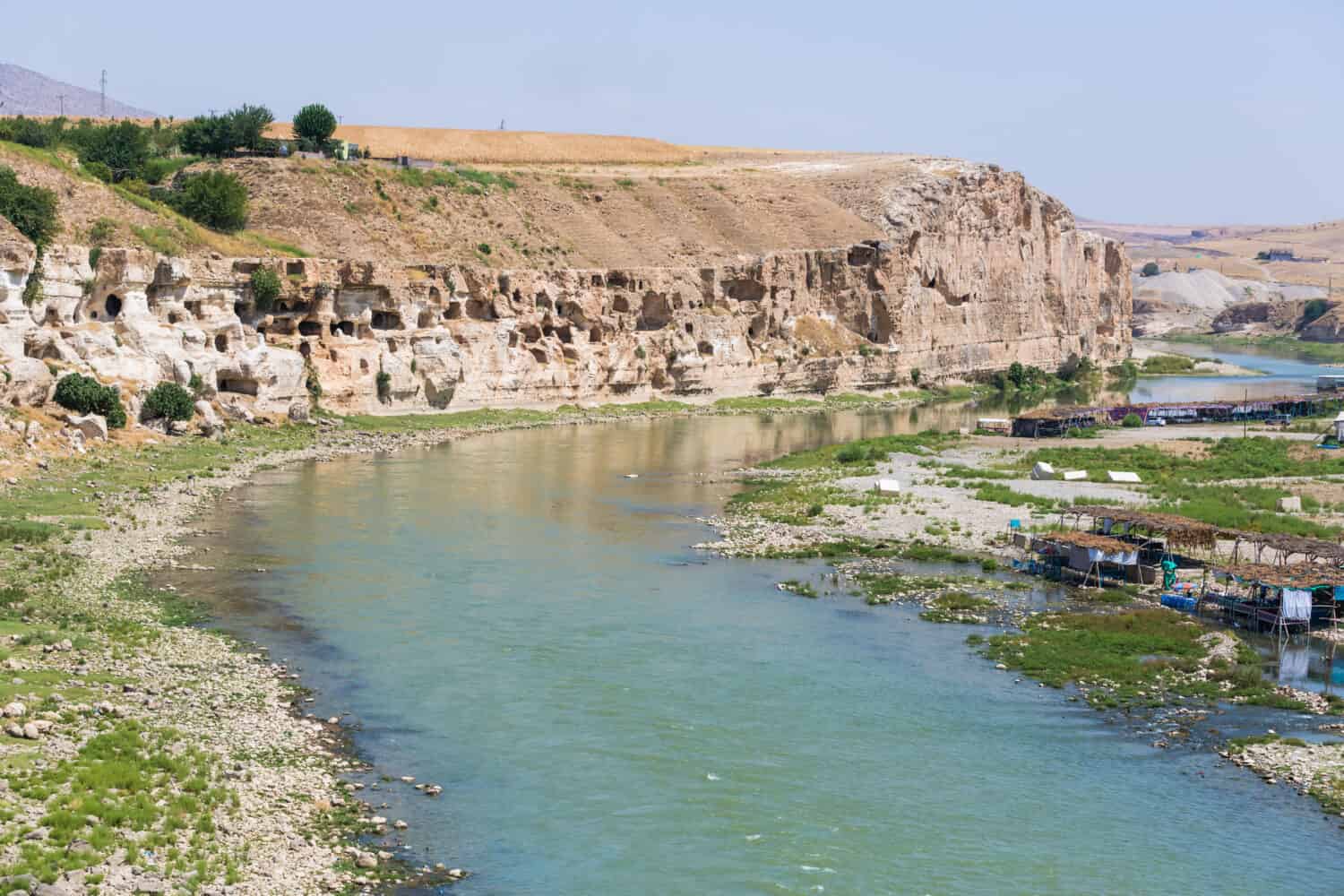
The Tigris River spans approximately 1,090 miles (1,750 kilometers) across Turkey, Syria, and Iraq.
©Inna Giliarova/Shutterstock.com
Conclusion
Tigris–Euphrates River system plays host to an impressive array of fish species. It is home to some of the largest fish in the Tigris River. The Bull Shark and Mangar are the most striking due to their large size. The Bull Shark, unique in its ability to survive in both saltwater and freshwater, finds the Tigris a suitable home due to its adaptable nature and pleasant water temperature. The Mangar is a notable native fish to the river. It has incredible resilience and is one of the largest freshwater fish in the world. The river’s unique habitat and ecological factors make it an ideal home for these sizable species. In conclusion, the Tigris River serves as an incredible sanctuary for a wide range of aquatic life, including some of the largest and most captivating fish found in the world.
The photo featured at the top of this post is © Jane Rix/Shutterstock.com
Thank you for reading! Have some feedback for us? Contact the AZ Animals editorial team.






